Olympus PEN E-PL5 Review
Olympus PEN E-PL5 Introduction
The Olympus PEN E-PL5, also known as the PEN Lite, is an entry-level Micro Four-Thirds mirrorless from Olympus. This digital camera is built around a 16 megapixels Four-Thirds sensor with a maximum ISO of 25600, fast 8 FPS full-resolution drive and 1080p HD video capability. It features built-in image stabilization and a hot-shoe with accessory port which supports an optional add-on EVF. The E-PL5 includes a small flash unit which attaches to the hot-shoe.
The E-PL5 distinguishes itself by having sophisticated video features. These include Program, Aperture-Priority, Shutter-Priority and Manual exposure. It offers plenty of video focus modes like continuous autofocus (AF-C), subject-tracking and direct manual-focus (DMF). It can record stereo sound via a built-in microphone or an external one which connects the the hot-shoe's accessory port.
This digital camera review analyses the ergonomics, usability, performance and image quality of the Olympus PEN E-PL5.
Olympus PEN E-PL5 Features
Sensor
- 16 Megapixels CMOS Four-Thirds sensor
- No Anti-Alias Filter
- Micro Four-Thirds lens mount
- Sensor-Shift image stabilization
- Built-in ultra-sonic dust-reduction
Exposure
- ISO 200 to 25600 sensitivity, 1 or 1/3 EV steps
- Auto ISO, customizable limit from 200 to 25600
- ISO Bracketing, 3 frames, maximum 1 EV increments
- 1/4000-60s Shutter-speeds, ½, 1/3 or 1 EV steps
- Live Bulb and Timed exposures up to 30 minutes
- PASM Exposure modes
- Program-Shift in P mode
- Exposure-Compensation, ±3, 1/3 or 1/2 EV increments
- Exposure-Shift, ±1, 1/6 EV increments
- Multi-Segment, Center-Weighed, Spot, Shadow Spot and Highlight Spot metering
- Auto-Exposure Bracketing, 3, 5 or 7 frames, maximum 1 EV steps except 1/2 EV for 7 frames
- Flash Bracketing, 3 frames, maximum 1 EV increments
- Flash-Compensation, ±3, 1/3 or 1/2 EV increments
- Auto, Redeye, Forced, Off, Slow-Sync+Redeye, Slow-Sync, Rear-Sync and Manual flash modes
- Manual flash power between full and 1/64th power
- Remote-Control flash
Image Parameters
- Automatic, 7 presetsSunny, Shade, Cloudy, Incandescent, Fluorescent, Underwater, Flash, kelvin and custom white-balance
- White-balance fine-tuning along 2 axis in 15 steps
- Digital white-balance preview
- White-balance bracketing, 1 or 2 axis, 3 frames along each axis, 3 step sizes
- Optional and automatic long shutter noise-reduction
- Optional high-ISO noise-reduction, 3 levels
- Picture Modes, 17 color and 2 monotone
- Adjustable contrast, sharpness, saturation, 5 steps each
- Adjustable gradation, automatic or 3 levels
- Adjustable tone curve, 15 steps for highlights and 15 steps of shadows
- sRGB or Adobe RGB color space
Focus
- Single-shot (AF-S), Continuous (AF-C), Direct Manual-Focus (DMF) or Tracking autofocus
- Manual-focus (MF), optional display magnification up to 14X
- 35-area AF system, automatic or manual point-selection
- Face-Priority toggle
- Controllable focus-ring direction
- Optionally reset lens focus to infinity
- Optional bulb focusing
- Optional AF-Assist lamp
Drive
- 8 FPS Continuous drive, 19 RAW or 15 JPEG
- Multiple-Exposure, 2 frames, optional automatic gain and composition overlay
- Self-timer, 2s, 12s or Custom1 - 10X shots
Video
- 1920x1080 @ 30 FPS Video using AVCHD codec
- 1280x720 @ 30 FPS Video using MPEG-4 codec
- Program, Aperture-Priority, Shutter-Priority and Manual video exposure
- Optional stereo sound with built-in microphone
- Optional external stereo microphone via a hot-shoe accessory port
Display & Viewfinder
- 3" Touchscreen LCD, 460K Pixels
- Depth-Of-Field Preview
- Optional Live-Histogram
- Optional guidelines, 4 types
- Optional blinking highlight
- Adjustable brightness, 15 steps
- Adjustable color, 15 steps, 1 axis
- Optional 0.2" EVF, 1.4 megapixels
Output Processing
- 4:3 Native aspect ratio
- 3:2, 16:9, 1:1 and 3:4 cropped aspect ratios
- 12, 8, 5, 3, 2 and 1.2 megapixels modes
- JPEG, RAW, RAW+JPEG capture
- 4 JPEG Compression levels
- Optional vignetting correction
Connectivity
- Hot-Shoe with Accessory port
- HDMI (1080i) output
- A/V (NTSC / PAL) output
- USB 2.0 connectivity
Misc
- Lens stabilization control, 3 modesBi-Directional, Horizontal, Vertical
- SDXC memory
- Lithium-Ion battery
- Custom DPI settings
- Custom Copyright data
NOTE The E-PL5 is internally nearly identical to the recently reviewed E-PM2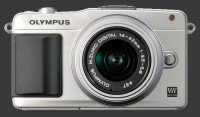
Olympus PEN E-PM2. If you have read its review, only the Usability section below warrants a read.
Olympus PEN E-PL5 Usability - How easy is it to use?
The Olympus PEN E-PL5 is a feature-rich mirrorless camera. It offers a plenty of advanced functions such as bracketing, multiple-exposures, tone-curve control and DOF preview. It also supports an outstanding number of customization options, with 63 options appearing in the configuration menu.
This relatively compact mirrorless camera is very well built except for a rather weak door covering the combined battery and memory card compartment. The hinge for the tilting LCD, often a weak-point, is of top-notch quality. The hand-grip is removable and held in-place via a single plastic screw which holds tighter than it looks.
The supplied hand-grip is quite shallow, yet provides a decent hold. There is a rubber thumb-rest at the back of the camera too. For maximum safety, the Olympus E-PL5 is supplied with a standard neck-strap which attaches to triangular eyelets on either side of the camera. Unfortunately, one of them digs into the finder while reaching the shutter-release which gets uncomfortable after a while. Larger cameras avoid this by having the release at the top of the grip.

The top of the camera holds a standard two-stage shutter-release, a small recessed power button and a mode-dial. The shutter has a distinct halfway-point which is nice to avoid accidentally taking a shot before the camera had time to focus. The small power button is responsive but hard to activate unintentionally. Further left is a hot-shoe between a pair of microphones to record stereo sound and a small speaker. Since the PEN E-PL5 does not have a built-in flash, a small add-on one is provided.
The mod-dial features the traditional PASM exposure modes, plus a very welcome Movie mode and positions for a Scene mode, an Art Filter mode and a fully Automatic one. The dedicated movie mode allows this camera to correctly preview framing for video which can also be captured blindly in all other modes.
Manual mode hides two features which are unique to Olympus. These have to be enabled in the setup menu: Live-Bulb and Live-Time. Both allow the progression of exposure to be monitored before the shutter is closed. The difference is that the former keeps the shutter open as long as the release is pressed, while the latter does so for a specified amount of time. In either case, there is a hard limit of 30 minutes.
The standard hot-shoe is paired with a proprietary accessory-port which supports an optional 0.2" EVF with 1.4 MP among other accessories such as an external stereo microphone. Given only one such port is present, only one add-on can be used at a time.
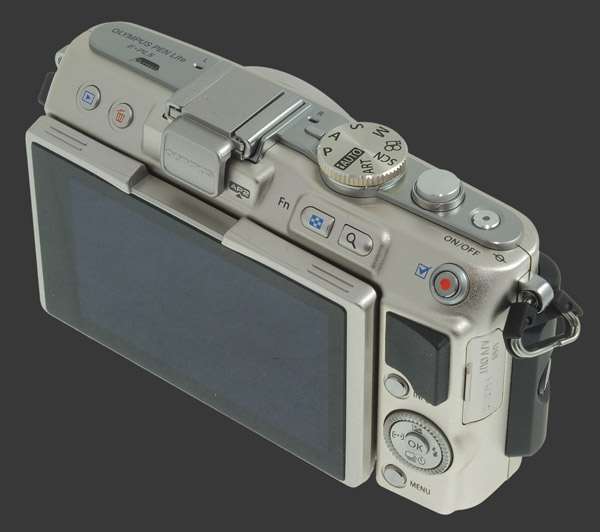
The remaining controls are on the back of the camera next to a wide-aspect ratio 3" touchscreen LCD with 460K pixels. The screen is sharp and, when combined with manual focus magnification, makes it possible to easily confirm focus. Visibility is decent but the contrast is lower than most modern cameras. An anti-reflection coating effectively prevents the display from washing out in bright light.
Touchscreen control is minimally implemented on the E-PL5. One can chose the focus-point and take a shot which is unfortunately easy to do accidentally. As with all touchscreens, smudges appear quickly and it is best to avoid using it.
One common problem about modern mirrorless cameras is the poor accuracy of their preview but as one of the pioneers of Live-View, Olympus actually gets it mostly right. The E-PL5 shows a reasonable Exposure-Priority preview in both Program and Manual mode but not in Aperture-Priority or Shutter-Priority. The Live-Histogram exhibits exactly the same problems.
WARNING There is a Frame Rate option in the setup menu which defaults to Normal. Setting it to High, the only other option, makes the preview completely incorrect.
The top rear control is the video recording button. Luckily, this button can be customized to access much more useful functions: EC, ISO, WB, AE-L/AF-L, DOF Preview, One-Touch Custom White-Balance, AF-Area Selection, Focus Point Home, Manual Focus, RAW, Test Picture, Backlit LCD, Underwater Mode, Live Guide, 2X Digital Zoom, Focus-Aid Magnification, HDR Bracket and 4 custom modes. The AE-L/AF-L function can be customized further using the Setup menu. Picking the right function here is a tough choice as AE-L / AF-L and DOF Preview cannot be activated any other way. ISO is an extremely useful option here.
To the left of the Video Record button is pair of buttons used for zooming in and out of images. In capture mode, the left most of these buttons is customizable with the same options as Video Record. The right one accesses MF-Assist magnification.
On the opposite side of the accessory-port, right above the LCD, the Playback and Delete buttons. There work just as usual. The E-PL5 is also shooting priority, so a half press of the shutter exists Playback mode as well. Delete does nothing in Capture mode.
Below the soft rubber thumb-rest are two buttons with a combined 4-way controller and control-dial between them. The buttons almost work as usual:
- Info: Usually cycles between various display modes in both Capture and Playback modes. A Setup option controls which modes get included in each cycle. In Capture mode after pressing the Up direction of the 4-way controller, the Info button cycles between EC, Highlight Tone-Curve and Shadow Tone-Curve.
- Menu: This button brings up a standard menu system. Two pages are optional, so the menu can have between 4 and 6 pages. When enabled, the Custom menu features a huge number of options arranged in 11 categories.
There is a lot going on with the 4-way controller which is customizable. The central OK button can bring up different controls, including the most useful one which is called SCP for Super Control Panel. The SCP gives access to plenty of camera settings using an interactive control panel. These settings thankfully include ISO, White-Balance with Fine-Tuning, Drive Mode, Flash Mode, Focus Mode, Flash-Compensation, Metering and Image Stabilization plus some less common settings like Picture Mode, Saturation, Contrast, Sharpness, Key, Image Quality, Face-Priority and Color-Space.
Each direction of the 4-way controller is assigned a function:
- Up is for Exposure-Compensation. This one is odd to use. Once active, Left and Right set the EC amount and Up and Down change the other exposure parameter which causes frequent accidental changes. OK must be pressed to exit this mode.
- Right is for Flash Mode. This can be replaced by ISO and WB among other not as useful settings.
- Down is for Drive Mode. This can be replaced by the same settings as the Right direction.
- Left is for selecting the focus point. Pressing OK returns to normal operations afterwards.
The Olympus PEN E-PL5 only has a single control-dial, which is normal for an intermediate camera. This is the rather thin dial which surrounds the 4-way controller. It rotates easily with soft well-spaced detents. While not so great and certainly too low, it works reasonably well.
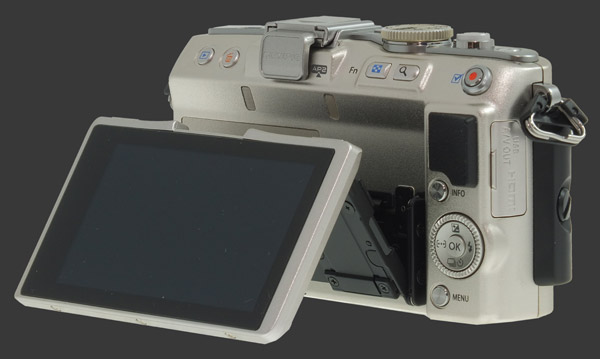
The last control of this camera is a double-hinge which can tilt the LCD upwards or downwards to shoot at add angles. This is useful when shooting from a tripod or away from eye-level. The display tilts 60° downwards and almost 180° upwards, so that the monitor is partially visible from the front of the camera. When the LCD is tilted upwards more than 120°, the image flips vertically to make it more usable.
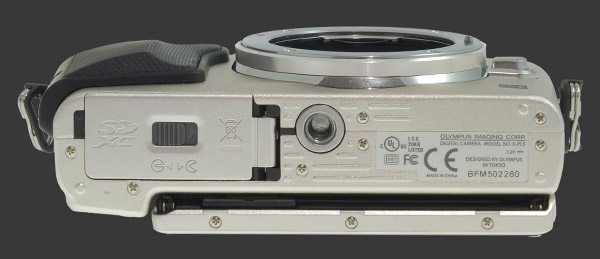
The bottom of this camera has a metal tripod mount centered relative to the camera which is good for balance but not for panoramas.
Overall, usability of the Olympus E-PL5 is good. It has both lots of controls and customization for a camera this size. With so many options, most important shooting options are accessible without too many button pressed. EC is always modal which requires caution to avoid dialing in the wrong setting.
Olympus PEN E-PL5 Performance - How well does it take pictures?
Performance starts with image quality, which is the criteria used as the foundation of our digital camera ratings. Ergonomic issues may get in the way, but in the end, image quality counts the most. For an ILC, image quality greatly depends on the lens used. While color, noise, exposure and dynamic-range are properties of a camera, distortion, vignetting and chromatic aberrations are properties of the lens. Sharpness and contrast depend on the weakest link. That is, a camera cannot capture more details than a lens lets through. Conversely, it is quite possible for a lens to transmit more details than a sensor can capture.
Image Noise & Details
The Olympus PEN E-PL5 shows very good image quality with clean results up to ISO 800. Noise is barely seen at ISO 1600 with little adverse effect. ISO 3200 makes noise clearly visible but details remain quite sharp and moderately large prints are completely usable. Only by ISO 6400 that we start seeing softness and fine details be eaten away. At this point it would be best to limit to medium-sized prints. ISO 12800 is more restrictive but remains usable for small prints. Leave ISO 25600 for emergencies.
This is an excellent performance and certainly one of the best for the price of this digital camera. It even slightly exceeds the more expensive OM-D E-M5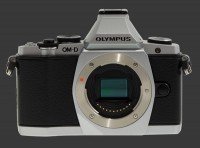
Olympus OM-D E-M5 because the E-PL5 does not have an anti-alias filter, while the E-M5 does.
There are three levels of noise-reduction available. Olympus improved the performance of their noise-reduction algorithms, making them less destructive than before. Particularly, the Low setting is gentle enough to be used permanently. The E-PL5 captures plenty of details which are optimally rendered with Sharpness set to +1 which produces artifact-free output.
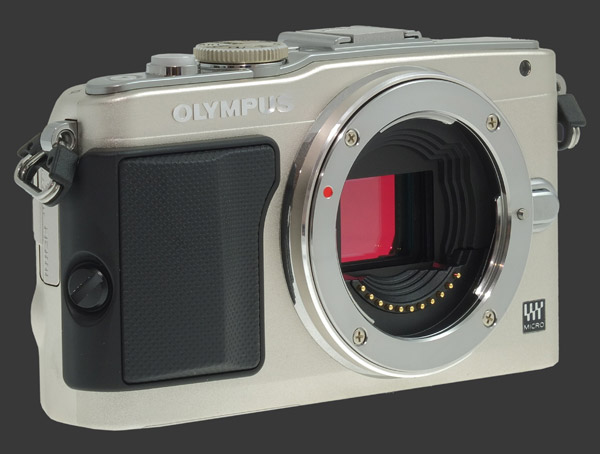
Color & White Balance
The E-PL5 has some difficulty with color accuracy. There are plenty of Picture Modes but none produce realistic colors across the spectrum. The best image colors are obtained in Natural style. Unfortunately, the red channel remains too high regardless of settings. This is obviously avoidable for those who shoot RAW.
Automatic While-Balance is excellent. It deals well with a variety of conditions including typical indoor lighting. There are tons of options for the rare cases when AWB has difficulty or to get consistent colors between shots. Custom WB is easy to use on this camera and renders whites perfectly neutral.
Exposure
This digital camera has an excellent multi-segment metering system. It overexposes sometimes when small and bright highlights are present in the scene. Generally, exposures come out perfectly usable without needing any exposure-compensation. Low contrast scenes are exposed towards the mid-tone which makes them look natural.
It is important to know that the LCD clips extreme highlights which may still be correctly captured. This happens when adjusting the highlight tone-curve too. Differences are barely noticeable on the LCD but images are in fact captured differently. Changes to the shadow tone-curve are much easier to see. When in doubt, the Playback histogram must be checked. The Live-Histogram is only truly accurate in M mode.
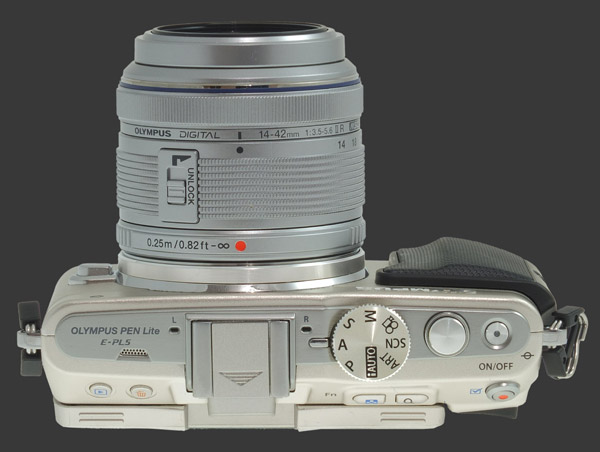
Auto Focus
The Olympus E-PL5 has a reasonably fast contrast-detect autofocus system. This is by far the most improved aspect compared to previous generations. This model locks focus quickly and accurately. Even in moderately low light, focus rarely takes more than ½s. Often, and particularly when light-levels are good, the E-PL5 locks focus in about ¼s. It does happen that things take longer, particularly at close range, up to 1s before giving up.
With most Micro Four-Thirds lenses, focus is done via a fly-by-wire ring around the lens-barrel. The Olympus E-PL5 keeps up well with no perceptible lag. In DMF mode, a slight turn of the focus-ring shift into manual focus. Because the ring is fly-by-wire, this camera can reverse the direction for focusing except for the few lenses with a mechanical focus-ring.
Speed
The E-PL5 is a rather responsive digital camera and faster than the E-PL3, though still slower than the flagship OM-D E-M5. The key autofocus system has been reworked and shows improved speed in good light. Low-light performance is reasonable but not great, particularly with a dim lens.
The following measurements characterize its performance:
- Power-On: Just over 1 second.
- Power-On to First-Shot: 1½ seconds.
- Autofocus: Down to ¼s, rarely more than ½s except in very low-light.
- Shutter-lag: Instant with 1s blackout.
- Shot-to-shot: Just under 1½s with AF, 1s in MF mode. Keep in mind that the 1s blackout means that at maximum speed there is no time to see what is being shot.
- Playback: ½s to enter, Instant exit.
- Power-Off: Under 1 second.
- Video: ½s to to start from Video mode, ½s to stop.
With numbers like this, the Olympus E-PL5 puts in a respectable performance on all fronts except video. The black-out times makes it difficult to follow action, but for general use this camera performs well. Autofocus speed is exemplary and really shows that Contrast-Detect is coming of age.
The Olympus PEN E-PL5 is powered by a proprietary Lithium-Ion battery which provides 360-shots per charge with 50% flash use. This is average among mirrorless cameras and should be enough for a day of shooting.
Olympus PEN E-PL5 Conclusion
The Olympus PEN E-PL5 delivers the highest image quality of any Micro Four-Thirds camera. It manages this in a solid and relatively compact body, delivering on the promise of mirrorless cameras to bring high image-quality to smaller form-factors. The subject is this review performs rapidly too, particularly in terms of autofocus speeds which have been a common problem for mirrorless cameras until recently.
The E-PL5 offers an impressive feature set and it has a good number of buttons to access it efficiently. It is also highly customizable and supports an optional EVF for eye-level shooting, which can greatly help for framing and shooting in bright light. Add to that a growing number of Micro Four-Thirds lenses from several vendors and the versatility of this digital camera is assured.
With image-quality that delivers usable images until ISO 12800, plus reliable metering and auto white-balance systems, the E-PL5 is a strong contender among mirrorless cameras. The speed of the autofocus system and responsiveness of the camera make it suitable for most photography, except for action where the 1s black-out time and shot-to-shot speed are longer than ideal.
To round things off, the Olympus PEN E-PL5 shows a respectable video performance. Output quality is good and there is only a short delay when starting to film. Plenty of video features are available, including using an external microphone using the proprietary accessory-port. This avoids the one serious video problem which is focus noise being recorded. Unfortunately, this happens in both AF and MF modes since MF is fly-by-wire on most Olympus lenses.
In the end, the Olympus PEN E-PL5 is an impressive offering which gives a run-for-its-money to the higher OM-D E-M5 which features a built-in EVF in a weather-sealed body with dual control-dials. Those who are looking for high image-quality and need versatility should seriously consider these two cameras. The E-PL5 provides the affordable option while the OM-D E-M5
Olympus OM-D E-M5 brings more direct controls favored by advanced photographers.
 |
Please Support Neocamera
All information on Neocamera is provided free of charge yet running this website is a huge endeavor. Purchases made via affiliate links found throughout the site help keep it running and up-to-date. There is no additional cost to you, so please consider buying via these links to our affilates:
If you found any information on this site valuable and did not purchase via our affiliate links, please considering donating via PayPal:
Any amount will be greatly appreaciated. Thank you for your support!
Olympus E-PL5 Highlights
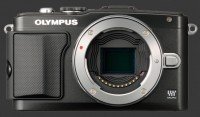
Sensor-Size: 17 x 13mm

Actual size when viewed at 100 DPI
| 16 Megapixels Mirrorless | ISO 200-25600 |
| Micro Four-Thirds Mount 2X FLM | Shutter 1/4000-60s |
| 2-Axis Built-in Stabilization | Full manual controls, including Manual Focus |
| 0.45" Optional EVF 1.5 Megapixels | Custom white-balance with 2 axis fine-tuning |
| 2 Axis Digital Level | Spot-Metering |
| Built-in Dust Reduction | Hot-Shoe |
| 8 FPS Drive, 15 Images | Stereo audio input |
| 1920x1080 @ 30 FPS Video Recording | Lithium-Ion Battery |
| 3" LCD 460K Pixels | Secure Digital Extended Capacity |
Updates
2025.01.18

Fujifilm GFX 2025 Lens Roundup
Lens Review roundup of Fujifilm GFX Medium-Format lenses. Quality, performance and handling of the GF20-35mm F/4R WR, GF30mm F/3.5 Tilt-Shift and the GF55mm F/1.7.
2024.11.18

Best 2024 Photography Gifts for Every Budget
Great gifts for photographers and photo enthusiasts selected for every budget among the best products of 2024.
2024.08.07

Eye Protection Tips for Professional Photographers
The four main considerations for professional photographers regarding eyewear.
2024.07.14

Fujifilm X100VI Review
Flagship fixed-lens compact digital camera with a 40 MP sensor and Image-Stabilization, a first for the series. Retro design featuring dual control-dials, plus direct ISO, Shutter-Speed and EC dials. Its hybrid viewfinder can switch between EVF and OVF mode.
2024.05.09

Fujifilm GFX100 II Review
Flagship 102 Megapixels Medium-Format Mirrorless Digital Camera with 8-Stop 5-Axis IBIS, 8 FPS Drive, 8K Video and 400 MP Super-Resolution capture in a weatherproof and freezeproof body with dual control-dials and dual memory-card slots.
2024.04.03

Fujifilm X-T5 Review
Newest Fujifilm flagship boasting a 40 MP APS-C sensor, 5-axis IBIS with 7-stop efficiency, 15 FPS continuous drive, 6.2K Video capture, dual control-dials and dual SDXC UHS-II slots in a sturdy weatherproof and freezeproof body.
2023.11.20

Best Digital Cameras of 2023
Find out which are the Best Digital Cameras of 2023. All the new Mirrorless Digital Cameras from entry-level to high-end professional.
2023.07.10

Fujifilm X-H2 Review
40 Megapixels APS-C Hybrid Mirrorless Digital Camera with 7-stop IBIS. Fastest shutter ever and 8K video capture. Large builtin EVF with 0.8X magnification and 5.8 MP, plus an Eye-Start Sensor. Packed with features and large number of controls in a weatherproof and freezeproof body.
2023.05.07

Sony FE 20-70mm F/4G Review
Review of the unique Sony FE 20-70mm F/4G lens. The optical zoom of this lens spans ultra-wide-angle and medium focal-length coverage, making it one of the most versatile Full-Frame lenses on the market.
2023.01.15

Huion Inspiroy Dial 2 Review
Review of the Huion Inspiroy Dial 2 tablet, a medium sized drawing surface with dual dials and customizable buttons. Connects via USB-C or Bluetooth 5.0 with Windows, Linux and Android support.
2022.12.08

How to Pack for a Photo Trip
Find out how to pack for a travel photography trip, carry your gear safely while meeting airline regulations.
2022.11.13

Best Digital Cameras of 2022
The best digital cameras of 2022. A short list of the most outstanding models in their respective categories. Choose one for yourself or as a gift.















